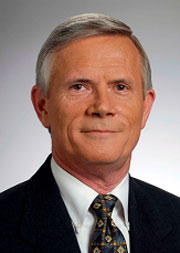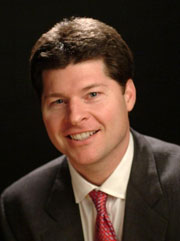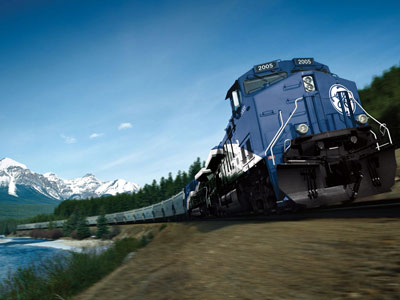To those who were intimately involved, Project Thomas was fast moving, intense, very complex and even fragile. The consensus was that if any one of the participating parties had balked or not come through, there would have been no project — at least not in Fort Worth, Texas.
But hurdles were overcome, and on the morning of Thursday, May 12, GE Transportation announced it would build a nearly US$100-million plant in Fort Worth to manufacture locomotives.
GE says the Fort Worth facility will eventually employ 775 people and turn out 250 to 300 locomotives a year. It will be the first U.S. factory outside its Erie base in more than a century.
Just the night before, the core participants in the deal were still working out the details. Veteran economic development professionals said the challenges presented made the project all the more memorable.

“This deal was very complex, and had a lot of moving parts to it,” says Vann Cunningham, assistant vice president for economic development with BNSF Railway Co. “It was one of those deals where you get to play at the top of your game. There are not too many projects that come along of this quality and size.”
David Berzina, executive vice president with the Fort Worth Chamber of Commerce, agrees: “This was probably the largest and fastest moving project that I have ever worked on in 23 years in three states.”
And for a project in which the primary manufactured product is to be locomotives, it was issues dealing with existing transportation infrastructure — both road and rail — that had to be solved if Fort Worth were to win the project.
Everyone involved agreed the project was fast-moving. A spokesperson for the Office of the Governor, Economic Development & Tourism, says GE’s initial meeting to discuss the project at Gov. Rick Perry’s office was April 5.

Berzina and Jay Chapa, director of housing and economic development for the City of Fort Forth, remember that initial meeting taking place in March. Berzina and Chapa also say it was apparent that GE had done much of its own due diligence and was specifically interested in Fort Worth as the only suitable site in Texas because of an existing, unoccupied 600,000-sq.-ft. (55,740-sq.-m.) building that was close to an existing BNSF rail line. The building was built by Atlanta-based IDI on a speculative basis right before the commercial real estate market essentially crashed, and had never been occupied.
“It was built before the recession hit when the market was very hot,” Berzina says. “It would take a specific [type of] end user, and finally, after about three years, one came along. So it brings to importance a spec facility to a community. If you are patient, sooner or later the building is going to go.”
GE’s due diligence before making contact with the Texas economic development officials had led the company to believe that BNSF’s main-line track running near the building would be re-routed and that the existing line, once the new main line was built, could serve as a future spur.
The spur would be absolutely critical for GE to deliver its locomotives to customers nationwide, as well as serve as a test track for new locomotives being turned out, said GE Transportation spokesman Stephan Koller.
And the IDI building would work by expanding it to 900,000 sq. ft. (83,610 sq. m.), as the company would later announce.
“When you produce the type of equipment that we do — locomotives that are 75 feet [23 m.] long and 16 feet [5 m.] high and 450,000 pounds [204,118 kg.] — you need very specific kind of building structures to accommodate that type of manufacturing. You need high bay,” Koller says.
Spurred to Change Plans
But even if GE could envision making the building work, its initial assumptions about the availability of rail proved wrong. It was true that the BNSF main line was to be re-routed. But because of earlier agreements between the company, the city, and Hillwood Properties, the track was to be removed, as in torn up completely. BNSF’s initial answer to GE’s query about the track running near the building, which GE had hoped would become its future vital spur, was that it was not going to happen.
Says Cunningham: “We told them (GE) that we didn’t think it would be possible to rail serve that building, and the reason was that under some agreements that were 20 years old, the track was slated to be removed.”
So the ability to provide for a rail spur would become the linchpin determining if and how the project could be successfully navigated to Fort Worth. Complicating matters further was a planned nearby highway diamond interchange that was designed with the main line’s removal in mind.
All the planned infrastructure changes had been agreed to in the 1990s. They had been negotiated and agreed to by BNSF, the City of Fort Worth and the Texas Department of Transportation, and Hillwood Properties, the developer of a 17,000-acre (6,880-hectare) master planned community called AllianceTexas.
By all accounts, Hillwood Properties is a business powerhouse in the Dallas-Fort Worth Metroplex. Not only is the company the area’s top residential developer, but it is also one of the top commercial real estate developers in the country. Hillwood was founded in 1988 by Ross Perot, Jr., who remains its chairman, and in 1989, the company opened Alliance Airport, billed as the world’s first industrial airport.
Today, Hillwood’s AllianceTexas has about 7,500 homes in its Heritage and Park Glen neighborhoods and the largest foreign trade zone in the United States. AllianceTexas is now home to 257 companies, including 50 from either the Fortune 500, Global 500 or Forbes list of Top Private Firms. These companies have built 31.2 million sq. ft. (2.9 million sq. m.) and created 28,000 jobs. AllianceTexas’ cumulative economic impact has now reached $38.5 billion, according to a February report from Insight Research Corp.
Prior to GE arriving on the scene, agreements had been negotiated to relocate the BNSF main line to permit for the expansion of a runway for the Alliance Airport, says Mark Berry, president of Hillwood Properties.
“We have been working for several years now with BNSF and the City of Fort Worth on coordinating the expansion of Alliance Airport, which is a pretty complicated construction project, because it requires the relocation of a highway, the main line of the BNSF and extension of runway,” says Berry.
“Part of the agreement between Hillwood and BNSF is that after the rail line was relocated and the old main line severed, that land would go into the airport expansion and the remaining railroad track would be assigned to Hillwood, so that we would have the ability to bring lead track or rail spurs into the project to support other industrial users.”
The IDI building that GE was eyeing is not a part of the Alliance development. To ensure that a future spur for GE could happen, Hillwood would essentially have to relinquish options on land that it had its sights on for a long time.
“I don’t think we ever envisioned this particular circumstance where we would have a major facility located just north of Alliance but along this track,” Berry says. “And we never really thought that a user like GE would come in with a locomotive manufacturing facility. But at the end of the day it worked out very well. They needed the track and we had the future rights to the track, so we coordinated a deal with the city, BNSF, GE and Hillwood to basically transfer our rights to the track to GE so that they could use it for testing of locomotives after they are produced there at the facility.”
By giving up its options on land that it could have used for its own development purposes, Berry says, Hillwood should benefit in that AllianceTexas will be able to provide real estate needs to future suppliers and support operations to GE.
The deal was hammered out relatively quickly, Berry says.
“We started working on it Monday morning and finished it by Wednesday night,” he says. The next morning, Thursday, May 12, the project was announced.
Cunningham also remembers a sprint to the finish line the night before the project was announced, culminating in a 9 p.m. conference call.
“We probably had 25 people on a teleconference call going over the different points, agreeing to a terms sheet which overnight was turned into a letter of intent which we, along with the other partners, allies and GE, signed,” he says.
You Can Get There From Here
If the project were to go forward, not only was an agreement with Hillwood critical, but so too was an agreement with the Texas Department of Transportation, which would have to revisit its plans to design a nearby highway interchange. The interchange between two highways was originally designed with the thought of the rail line being removed, says Chapa.
“We had to work closely with TexDot to determine what it would take to redesign the current design that we had been working on that would then leave the rail line in place so that GE could use it,” Chapa says.
In the end, the highway department determined that a redesigned interchange diamond was possible with the rail line remaining in place, albeit at an extra cost. However, highway officials were comfortable that the increased costs would not exceed the budgeted total.
“The contingency amount in the original budget was enough to cover the increase in costs. So we didn’t have to go back to any of the local funding sources to ask for more money,” Chapa says.
The fragility of the GE project stemmed from the fact that so many parties — Hillwood, the Texas Department of Transportation, BNSF, the City of Fort Worth and Denton County — had to take action for new agreements to be reached.
“It took a spirit of community cooperation and a willingness [from] all of the parties,” says BNSF’s Cunningham. “At any given point, Hillwood, ourselves, the city, Denton County — any one of the parties — could have caused this project to not happen.
“To make it happen, they all had to agree and come together. Well less than 12 hours before the announcement, we were still on the phone, with all the parties involved trying to come to agreement on the terms of the deal, so it really did come down to last moment. I don’t wish the folks in North Carolina any ill will, but the folks in Fort Worth really came together.”
GE Transportation spokesman Koller says the company looked at GE properties in Erie, Pa. and Lynn, Mass., and at sites in other states that he would not name. Chapa, like Cunningham, says a North Carolina site was apparently under consideration. Some press reports indicate that Georgia and Mexico may have been considered.
Gov. Perry said the state is investing $4.2 million in the project through the Texas Enterprise Fund (TEF), pointing out that this venture “will continue to strengthen the economy in North Texas and in our state, creating jobs and prosperity for hundreds of Texans.”
At Gov. Perry’s request, the TEF was created in 2003 to help attract new jobs and investment to the state. The fund has since become one of the state’s most competitive tools to recruit and bolster business. To date, the TEF has invested more than $435.3 million and closed the deal on projects generating 58,179 new jobs and more than $14.6 billion in capital investment.
Right Place, Right Time
Expanding into Texas will provide GE Transportation with a manufacturing base in the state with the most railroad route miles in the U.S. The Lone Star State’s 10,405 railroad route miles (16,741 km.) outstrip the 7,313 miles of No. 2 Illinois, according to the Association of American Railroads. As anyone who’s watched the train traffic going through downtown Fort Worth knows, Texas is served chiefly by the Union Pacific Railroad and BNSF.
Demand for freight shipments in North America is improving as the U.S. economy recovers. U.S. volumes excluding grain and coal shipments rose 7.9 percent to 4.6 million carloads in the quarter ended March 31, according to the Association of American Railroads. It was the second-highest increase in a first quarter, after last year’s 9.3-percent advance.
Locomotive demand is climbing, too. GE Transportation’s first-quarter backlog was about $4.1 billion, 40 percent more than a year earlier, GE Chief Financial Officer Keith Sherin said in an April 21 conference call. First-quarter orders for rail cars, which GE doesn’t make, rose to the highest since 1997.
GE Transportation is the maker of the Evolution® Series locomotive, which will be produced at the Fort Worth plant. This newer-generation locomotive reduces fuel use by 5 percent or approximately 640,000 gallons over its lifetime, while reducing emissions by about 40 percent.
GE will be moving into a city with a long tradition of manufacturing, which clearly was a factor of consideration, says Berzina with the Fort Worth Chamber.
“In our initial meeting with GE, they had an HR representative there, and they asked if we thought there would be any difficulty in securing 750 or so manufacturing-related jobs,” he says. “We discussed with them the fact that Lockheed Martin has 15,000 employees here and they are making the most technologically advanced fighter aircraft in the world. We told them that Bell Helicopter has a major manufacturing facility here in Fort Worth.
“We talked about Arlington’s sport utility vehicle plant 15 miles [24 km.] east where GM manufactures the Cadillac Escalade and GMC Yukon Denalis. And we told them that we had a population within our city limits of about 750,000 and within 60 miles [97 km.] we had 6.4 million people, and that we are the fastest growing MSA in the United States. I told them if there was any place in the United States that would not have difficulty in addressing quantity and quality of skilled work force, it was Dallas-Fort Worth.”
In a prepared statement, Fort Worth Mayor Mike Moncrief alluded to the manufacturing tradition:
“We are thrilled to welcome GE Transportation to our community. They enhance the already impressive list of great companies that have made Fort Worth their home or a significant part of their business.
“GE Transportation is bringing state-of-the-art green technology that will power the transportation business through the rest of this century. What they are doing complements both our city’s commitment to sustainable growth and development, as well as our efforts to develop answers to our mobility challenges. We believe this is the first important step in what will be a long and sustained relationship. It is one that will ensure not only success for GE Transportation, but will also continue the steady growth we see in our city and around the North Texas region.”
Dean Barber is the president/CEO of Barber Business Advisors, LLC, a site selection and economic development consulting firm in Red Oak, Texas — www.barberadvisors.com.
